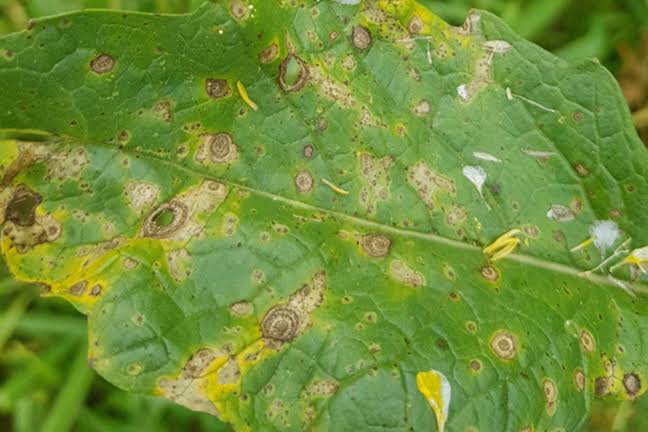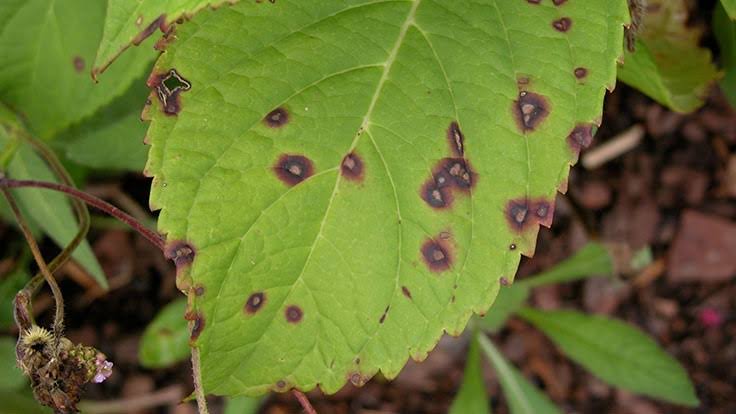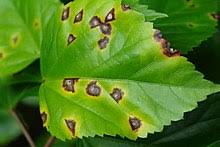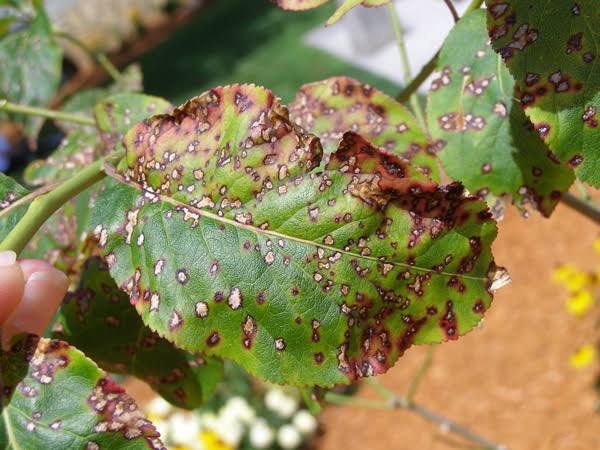Leaf spot diseases, such as anthracnose and septoria leaf spot, are common afflictions that impact various plants. These diseases are caused by different fungi, leading to distinctive symptoms and challenges for gardeners.
Anthracnose, scientifically known as Colletotrichum spp., is a fungal disease affecting a range of plants, including trees, shrubs, and vegetables. It thrives in warm and humid conditions, making it a recurring issue in certain regions. The telltale signs of anthracnose include small, dark spots on leaves that gradually enlarge and may develop concentric rings. Over time, these spots can cause leaf yellowing, premature leaf drop, and, in severe cases, affect the overall health of the plant.
On the other hand, septoria leaf spot, caused by the fungus Septoria spp., is another common concern for gardeners. This disease often targets tomato plants but can also affect other crops like potatoes. The scientific name highlights the specific genus responsible for the infection. Septoria leaf spot manifests as small, circular lesions with a light-colored center and dark edges. As the disease progresses, these spots merge, leading to significant leaf damage and potential yield loss.
Managing leaf spot diseases requires a multi-faceted approach. Cultural practices, such as proper spacing of plants to enhance air circulation, can help reduce humidity levels and discourage fungal growth. Regularly removing infected leaves and practicing crop rotation can also mitigate the spread of these diseases. Additionally, applying fungicides at the first signs of infection can be an effective preventive measure.
It’s crucial for gardeners to stay vigilant and monitor their plants regularly for any symptoms of leaf spot diseases. Early detection and intervention play a key role in minimizing the impact of these fungal infections. By understanding the nature of anthracnose, septoria leaf spot, and similar diseases, gardeners can implement informed strategies to foster healthy plants and thriving gardens.
Read Also: 16 Medicinal Health Benefits Of Ambrosia arborescens (Giant Ragweed)
Plants Affected by Leaf Spot Diseases

Leaf spot diseases can affect a wide variety of plants, causing concern for gardeners and farmers alike. Ornamental plants, fruit-bearing trees, and vegetables are among the diverse range of vegetation susceptible to these fungal infections.
1. Trees:
Maple Trees: Anthracnose can target maple trees, leading to dark spots on leaves and potential defoliation.
Oak Trees: Similar to maples, oak trees can also suffer from anthracnose, impacting their overall health.
2. Shrubs:
Azaleas: Anthracnose and septoria leaf spot can affect these popular flowering shrubs, leading to blemished leaves.
Rhododendrons: These ornamental shrubs are not immune to leaf spot diseases, and proper care is essential for their well-being.
3. Vegetables:
Tomatoes: Septoria leaf spot is a common concern for tomato plants, affecting both leaves and fruit.
Potatoes: Similar to tomatoes, potatoes can fall victim to septoria leaf spot, potentially reducing yields.
4. Fruit-bearing Plants:
Apple Trees: Anthracnose may impact apple trees, causing lesions on leaves and affecting fruit quality.
Grapevines: Leaf spot diseases can affect grapevines, potentially impacting grape production and quality.
5. Flowering Plants:
Roses: Anthracnose can mar the beauty of rose plants, leading to spotted and discolored leaves.
Lilies: These popular flowers are not immune to leaf spot diseases, and gardeners need to be watchful for symptoms.
Understanding the susceptibility of different plants to leaf spot diseases is crucial for implementing effective preventive measures. Regular inspections, proper spacing, and the timely removal of infected plant parts are essential practices to maintain the overall health of diverse plant species in gardens and agricultural settings.
Damages Caused by Leaf Spot Diseases

Leaf spot diseases can inflict various damages on plants, impacting their overall health and productivity. The extent of the damage depends on factors such as the specific pathogen, environmental conditions, and the susceptibility of the plant species. Here are some common damages caused by leaf spot diseases:
1. Reduced Photosynthesis: Infected leaves often experience reduced chlorophyll production due to the formation of lesions. This diminishes the plant’s ability to photosynthesize effectively, limiting its capacity to produce energy for growth and development.
2. Premature Leaf Drop: Both anthracnose and septoria leaf spot can lead to premature leaf drop. Infected leaves may become weakened, causing them to fall off before completing their natural lifespan. This premature defoliation can compromise the plant’s ability to nourish itself and adversely affect its aesthetics.
3. Decreased Yield: When leaf spot diseases affect fruit-bearing plants like tomatoes and apples, the overall yield may be significantly reduced. Fungal infections can extend to the fruits, causing blemishes, rotting, or a decrease in size and quality.
4. Stunted Growth: Continuous infection and defoliation can result in stunted growth of affected plants. This is particularly detrimental for young plants or those in critical growth stages.
5. Weakened Plant Immunity: Leaf spot diseases weaken the plant’s natural defense mechanisms. This makes it more susceptible to other pathogens, pests, and environmental stressors, creating a cycle of compromised plant health.
6. Impact on Aesthetics: Ornamental plants such as roses, azaleas, and lilies can suffer aesthetically. The presence of unsightly spots and discoloration on leaves diminishes the visual appeal of these plants, affecting their ornamental value.
7. Spread to Nearby Plants: If not properly managed, leaf spot diseases can spread to nearby plants. Fungal spores can be carried by wind, rain, or even through contact with contaminated tools, potentially leading to a broader outbreak.
Addressing leaf spot diseases promptly is crucial to mitigate these damages. Implementing cultural practices, applying fungicides when necessary, and maintaining overall plant health are essential strategies to minimize the impact of leaf spot diseases on cultivated plants.
Read Also: 16 Medicinal Health Benefits Of Anacardium othonianum (Cashew tree)
Control and Preventive Measures

Effective control and preventive measures are essential to manage and mitigate the impact of leaf spot diseases on plants. Here are some strategies that gardeners and farmers can implement:
1. Cultural Practices:
Prune Infected Parts: Regularly prune and remove infected leaves, branches, or plant parts to reduce the spread of the disease.
Proper Plant Spacing: Ensure adequate spacing between plants to enhance air circulation, which can help reduce humidity and create an environment less favorable for fungal growth.
2. Hygiene and Sanitation:
Clean Garden Tools: Regularly sanitize gardening tools, such as pruning shears, to prevent the transmission of fungal spores from one plant to another.
Clean Debris: Remove and dispose of fallen leaves and plant debris promptly to eliminate potential sources of infection.
3. Water Management:
Avoid Overhead Watering: Water the plants at the base to minimize moisture on the leaves, as leaf spot diseases thrive in humid conditions.
Well-Drained Soil: Ensure proper drainage in the planting area to prevent waterlogged conditions that can contribute to fungal growth.
4. Resistant Varieties:
Choose Resistant Plants: Opt for plant varieties that exhibit resistance to specific leaf spot diseases. This can be an effective preventive measure in areas where these diseases are prevalent.
5. Fungicides:
Timely Application: Use fungicides as a preventive measure or at the first signs of infection. Follow recommended application rates and schedules for optimal effectiveness.
Rotate Fungicides: To prevent the development of resistance, rotate between different fungicides with different modes of action.
6. Crop Rotation:
Rotate Crops: Practice crop rotation to disrupt the life cycle of pathogens and reduce the buildup of soil-borne diseases.
7. Monitoring:
Regular Inspection: Conduct regular inspections of plants for early detection of symptoms. Early intervention is crucial in controlling the spread of leaf spot diseases.
8. Weather Monitoring:
Be Weather-Aware: Keep an eye on weather conditions, especially during periods of high humidity or prolonged wetness, as these conditions favor the development of leaf spot diseases.
Implementing a combination of these measures tailored to the specific plant species and local conditions can contribute to effective control and prevention of leaf spot diseases. Consistent vigilance and proactive management are key to maintaining healthy plants and minimizing the impact of these fungal infections.
Frequently Asked Questions (FAQs) About Leaf Spot Diseases (Colletotrichum spp.)
Q1: What are leaf spot diseases?
A: Leaf spot diseases are fungal infections that affect plants, causing characteristic spots on leaves. Common examples include anthracnose and septoria leaf spot.
Q2: Which plants are susceptible to leaf spot diseases?
A: Various plants, including trees (maples, oaks), shrubs (azaleas, rhododendrons), vegetables (tomatoes, potatoes), fruit-bearing plants (apple trees, grapevines), and flowering plants (roses, lilies), can be susceptible.
Q3: What are the symptoms of leaf spot diseases?
A: Symptoms include small, dark spots on leaves that may enlarge, concentric rings, leaf yellowing, premature leaf drop, and, in severe cases, impact on overall plant health.
Q4: How can I prevent leaf spot diseases?
A: Preventive measures include proper plant spacing, sanitation (cleaning tools and removing debris), avoiding overhead watering, choosing resistant plant varieties, using fungicides as needed, practicing crop rotation, and regular monitoring.
Q5: Can leaf spot diseases spread to other plants?
A: Yes, fungal spores can be carried by wind, rain, or contaminated tools, potentially spreading leaf spot diseases to nearby plants.
Q6: How do I treat leaf spot diseases once detected?
A: Treatments include pruning infected parts, applying fungicides at the first signs of infection, and ensuring good plant hygiene practices.
Q7: Are there natural or organic methods to control leaf spot diseases?
A: Yes, cultural practices like proper spacing, sanitation, and choosing resistant plant varieties are organic methods. Additionally, some copper-based fungicides are approved for organic gardening.
Q8: Can weather conditions impact the development of leaf spot diseases?
A: Yes, high humidity and prolonged wetness can create favorable conditions for the development of leaf spot diseases. Monitoring weather conditions is important for disease management.
Q9: Can leaf spot diseases be completely eradicated?
A: While complete eradication may be challenging, proactive management strategies can effectively control and minimize the impact of leaf spot diseases.
Q10: Can I eat fruits or vegetables affected by leaf spot diseases?
A: Fruits or vegetables affected by severe leaf spot diseases may have reduced quality, but in some cases, they may still be safe to eat after careful inspection and proper washing.

